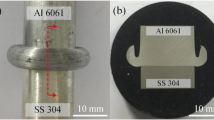Abstract
Fusion welding of steel to aluminum is difficult due to formation of different types of Fe-Al intermetallics (IMs). In this work, 2 mm-thick steel was joined to 6 mm aluminum in overlap configuration using a 8 kW CW fiber laser. A defocused laser beam was used to control the energy input and allow melting of the aluminum alone and form the bond by wetting of the steel substrate. Experimentally, the process energy was varied by changing the power density (PD) and interaction time separately to understand the influence of each of these parameters on the IM formation. It was observed that the IM formation is a complex function of PD and interaction time. It was also found that the mechanical strength of such joint could not be simply correlated to the IM layer thickness but also depends on the area of wetting of the steel substrate by molten aluminum. In order to form a viable joint, PD needs to be over a threshold value where although IM growth will increase, the strength will be better due to increased wetting. Any increase in interaction time, with PD over the threshold, will have negative effect on the bond strength.













Similar content being viewed by others
Abbreviations
- Fe:
-
Iron
- Al:
-
Aluminum
- IM:
-
Intermetallic
- FMIP:
-
Fundamental material interaction parameters
- E sp :
-
Specific point energy (kJ)
- P :
-
Laser power (kW)
- TS:
-
Travel speed (cm min−1)
- D beam :
-
Laser beam diameter (mm)
- PD:
-
Power density (kW cm−2)
- t i :
-
Interaction time (s)
- A beam :
-
Laser beam area (cm−2)
References
E. Taban, J.E. Gould, and J.C. Lippold, Dissimilar Friction Welding of 6061-T6 Aluminum and AISI, 1018 Steel: Properties and Microstructural Characterization, Mater. Des., 2010, 31(5), p 2305–2311
K. Bouche, F. Barbier, and A. Coulet, Intermetallic Compound Layer Growth Between Solid Iron and Molten Aluminium, Mater. Sci. Eng. A, 1998, 249(1-2), p 167–175
S. Kobayashi and T. Yakou, Control of Intermetallic Compound Layers at Interface Between Steel and Aluminum by Diffusion-Treatment, Mater. Sci., 2002, 338, p 44–53
R. Borrisutthekul, T. Yachi, Y. Miyashita, and Y. Mutoh, Suppression of Intermetallic Reaction Layer Formation by Controlling Heat Flow in Dissimilar Joining of Steel and Aluminum Alloy, Mater. Sci. Eng. A, 2007, 467(1-2), p 108–113
P. Pl, Explosion-Bonded Transition Joints for Structural Applications, Building, 1989, 3(2), p 64–72
F. Findik, Recent Developments in Explosive Welding, Mater. Des., 2011, 32(3), p 1081–1093
G. Çam and M. Koçak, Progress in Joining of Advanced Materials—Part 1: Solid State Joining, Fusion Joining, and Joining of Intermetallics, Sci. Technol. Weld. Join., 1998, 3(3), p 105–126
E. Assuncao, Investigation of Conduction to Keyhole Mode Transition, Cranfield University, 2012
J. Fan, C. Thomy, and F. Vollertsen, Effect of Thermal Cycle on the Formation of Intermetallic Compounds in Laser Welding of Aluminum-Steel Overlap Joints, Phys. Procedia, 2011, 12, p 134–141
W.J. Suder and S. Williams, Power Factor Model for Selection of Welding Parameters in CW Laser Welding, Opt. Laser Technol., 2014, 56, p 223–229
E. Assuncao, S. Williams, and D. Yapp, Interaction Time and Beam Diameter Effects on the Conduction Mode Limit, Opt. Lasers Eng., 2012, 50(6), p 823–828
E. Schubert, D.I. Zerner, and P.G. Sepold, Lasers Material Processing, Proc. SPIE, 1997, 3097, p 212–221
H. Ozaki and M. Kutsuna, Laser-Roll Welding of a Dissimilar Metal Joint of Low Carbon Steel to Aluminium Alloy Using 2 kW Fibre Laser, Weld. Int., 2009, 23(5), p 345–352
A. Mathieu, R. Shabadi, A. Deschamps, M. Suery, S. Matteı, D. Grevey, and E. Cicala, Dissimilar Material Joining Using Laser (Aluminum to Steel Using Zinc-Based Filler Wire), Opt. Laser Technol., 2007, 39, p 652–661
Y. Miyazaki and S. Yasunobu, Tensile Shear Strength of Laser Welded Lap Joints, Nippon Steel Tech. Rep., 2007, 95, p 28–34
Acknowledgments
Dr. Supriyo Ganguly acknowledges the support by EPSRC through Grant Number EP/J017086/1. Sonia Meco is grateful to BAE Systems Naval Ships for providing financial support to this project.
Author information
Authors and Affiliations
Corresponding author
Rights and permissions
About this article
Cite this article
Meco, S., Ganguly, S., Williams, S. et al. Effect of Laser Processing Parameters on the Formation of Intermetallic Compounds in Fe-Al Dissimilar Welding. J. of Materi Eng and Perform 23, 3361–3370 (2014). https://doi.org/10.1007/s11665-014-1106-5
Received:
Revised:
Published:
Issue Date:
DOI: https://doi.org/10.1007/s11665-014-1106-5




